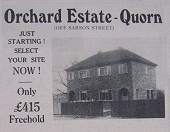 |
|
 |
St. Bartholomew's Church
The earliest mention of the Church is that Ranulf, 4th Earl of Chester left the church at Barrow with its chapel at Quorn to Leicester Abbey in his will of 1153. The original building is about 800 years old and up to 1868 was a chapelry under the mother church of Barrow-upon-Soar.
The church owes its foundation as a chapel to the Norman Lords' passion for hunting. Farnham Records suggest that the possible reason for the building of a church at Quorn was that the Earl of Chester living at Barrow manor held parties to hunt the Charnwood area for deer. When the floods cut off their return to Barrow, he then had built a religious building to the west of the floods for their worship.
A small bridge known as Priest's Bridge was built at this time (1153) to enable the curate to cross the Soar and reach the chapel.
In 1392 the local folk were unhappy that the church was only open three days a week and John Farnham applied to the Crown for permission to use the income from some land and houses to maintain a chantry priest "so that there should be daily service in the chapel". This was granted by Richard II. To us today, a daily service might seem over zealous, but religion was the central focus of medieval life and the church the focal point of the village. In these times it is thought that there were no seats in church, except for the elderly and infirm, and congregations sat on the floor on straw or rushes.
The priest provided education for boys, acted as a social worker to those infirm or in need and collected tithes to supplement his living.
By the fifteenth century the chapel had, in addition to the central nave and chancel, both aisles, a porch (built 1270-1340) with a priest's room built over it and a square fourteenth century tower.
No evidence exists of the views of local people towards the religious changes imposed on them by the Reformation, we can only guess at their confusion.
The restoration of the Townlands Charity in 1633 (which had previously part paid the priest's salary) encouraged the churchwardens to appeal to the village for funds to repair the now dilapidated church. This was met with refusal by the inhabitants and eventually the churchwardens had to appeal to the Archbishop of Canterbury, to enforce the levy. There is no record of his judgement, but no repairs were carried out during the Civil War period.
More settled times followed the restoration of the monarchy (1660) which enabled the wardens at last to collect funds to restore the "decaying and very much ruined chapel". One landowner, Francis Harris, refused to pay more than one shilling. He took lead from the roof and broke up the font, doing serious damage. He failed to appear in court and after three years was excommunicated.
We move forward in time now to 1766 when the local historian, Nicholls notes that "some villains broke into the chapel at Quorndon and robbed it of the communion plate and linen, viz a silver cup and cover, a table cloth and napkin, with a breadth of a new surplus, supposed to have been torn off to wrap the booty".
In 1763 parliament had passed an Enclosure Act compacting the medieval strip farming system into enclosed units. The three great open fields of Quorn were enclosed allowing landowners to enclose their separate holdings. Feudal tithes were abolished and to compensate, the priest was given an allotment of land in his own right. The Church of England apparently failed to respond to the changing social climate, not recognising that the changes had brought about widespread poverty in the area. More and more people were attending the non-conformist chapels which were becoming established in the village. The dissenters objected most strongly to paying for the upkeep of St Bartholomew's Church, since they had left and now had their own chapels to maintain.
The village population expanded rapidly in the Victorian era and the north aisle was enlarged in 1842 to provide an additional 167 seats, of which 109 were rent-free. In 1868 Quorn became a parish, separate from Barrow and the first curate, the Rev Robert Stammers, became the first vicar of Quorn.

| |
|
|
 |
Submitted on: |
2009-07-01 |
 |
Submitted by: |
Kathryn Paterson |
 |
Artefact ID: |
76 |
 |
Artefact URL: |
www.quornmuseum.com/display.php?id=76 |
 |
Print: |
View artefact in printer-friendly page or just on its own (new browser tab). |
|
|
 |
|
 |












